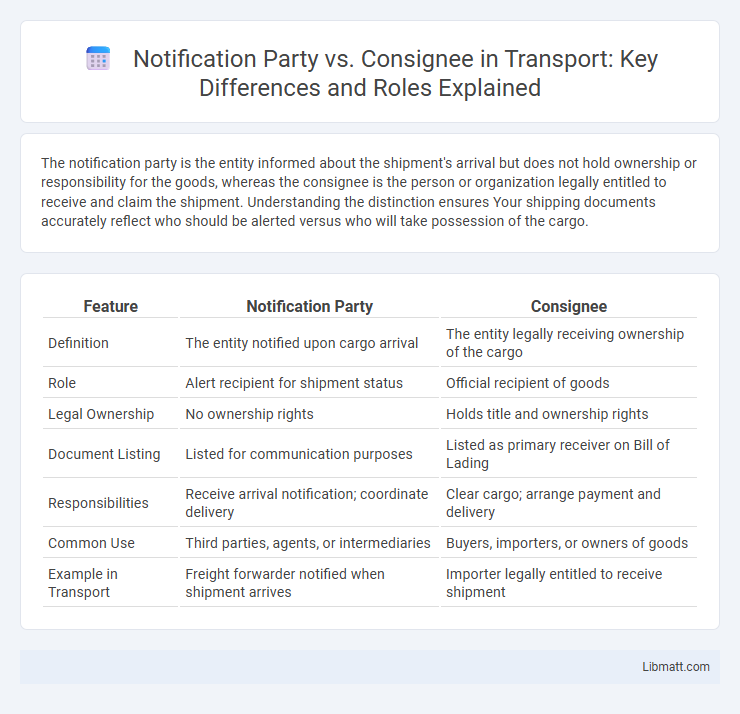The notification party is the entity informed about the shipment's arrival but does not hold ownership or responsibility for the goods, whereas the consignee is the person or organization legally entitled to receive and claim the shipment. Understanding the distinction ensures Your shipping documents accurately reflect who should be alerted versus who will take possession of the cargo.
Table of Comparison
| Feature | Notification Party | Consignee |
|---|---|---|
| Definition | The entity notified upon cargo arrival | The entity legally receiving ownership of the cargo |
| Role | Alert recipient for shipment status | Official recipient of goods |
| Legal Ownership | No ownership rights | Holds title and ownership rights |
| Document Listing | Listed for communication purposes | Listed as primary receiver on Bill of Lading |
| Responsibilities | Receive arrival notification; coordinate delivery | Clear cargo; arrange payment and delivery |
| Common Use | Third parties, agents, or intermediaries | Buyers, importers, or owners of goods |
| Example in Transport | Freight forwarder notified when shipment arrives | Importer legally entitled to receive shipment |
Introduction to Notification Party and Consignee
The notification party is the entity designated to receive shipment updates and documents but does not hold ownership or responsibility for the cargo, unlike the consignee who is the actual recipient and legally responsible for the goods upon arrival. Understanding the distinction between the notification party and consignee is crucial for accurate shipping documentation and efficient logistics management. Your shipping process relies on correctly identifying both to ensure timely communication and proper cargo delivery.
Key Definitions: Notification Party vs Consignee
The consignee is the individual or entity legally entitled to receive the shipment and is responsible for clearing customs and taking possession of the goods. The notification party is a third party designated to be informed about the shipment's arrival but holds no legal rights or responsibilities over the cargo. Understanding these roles helps ensure clear communication and proper handling of your shipments during the delivery process.
Roles and Responsibilities Explained
The consignee is the recipient of the shipment and holds the responsibility for accepting delivery and managing the goods upon arrival. The notification party is the entity designated to receive shipment updates and alerts but may not have ownership or handling duties for the cargo. Understanding the distinct roles helps ensure efficient communication and smooth customs clearance processes for your international shipments.
Importance in International Shipping
In international shipping, the notification party is crucial for ensuring timely updates on the shipment status, allowing recipients to prepare for customs clearance and delivery. The consignee holds ownership and assumes responsibility for the cargo upon arrival, making accurate identification essential to prevent legal and logistical issues. Proper distinction between the notification party and consignee enhances communication efficiency and reduces delays in the supply chain.
Notification Party: Purpose and Functions
The notification party in international shipping serves as the designated contact who is informed about the cargo's arrival and shipment status but does not hold ownership rights like the consignee. This entity facilitates communication between the carrier, consignee, and other stakeholders, ensuring timely updates for customs clearance, delivery coordination, and logistical planning. Unlike the consignee, responsible for receiving and owning the goods, the notification party acts as an intermediary to streamline the flow of critical shipment information.
Consignee: Legal Rights and Obligations
The consignee holds legal rights to receive goods and is responsible for customs clearance, payment of duties, and adherence to import regulations. Unlike the notification party, who is only informed about the shipment status, the consignee has contractual obligations to accept delivery and manage ownership transfer. Legal disputes concerning cargo typically involve the consignee, as they possess the authority to claim ownership and liabilities attached to the shipment.
Differences Between Notification Party and Consignee
The notification party is the entity informed when a shipment arrives but does not have ownership rights, while the consignee is the person or organization legally entitled to receive and take possession of the goods. Your consignee is responsible for customs clearance and accepting delivery, whereas the notification party acts solely as a contact point for updates and communication. Understanding these distinctions ensures proper handling and reduces delays in shipping and logistics.
Impact on Shipping Documents and Customs Clearance
The notification party and consignee play distinct roles in shipping documents impacting customs clearance processes. The consignee is the primary recipient listed on the bill of lading and is responsible for customs duties and goods release, while the notification party merely receives shipment updates without customs obligations. Clear identification of the consignee ensures smooth customs clearance and prevents delays, whereas the notification party helps keep your stakeholders informed without affecting the legal clearance process.
Common Scenarios and Examples
In international shipping, the consignee is the entity legally entitled to receive the goods, while the notification party is the individual or company informed upon the shipment's arrival. Common scenarios include shipments where the consignee is a freight forwarder or buyer, and the notification party is a warehouse or customs broker responsible for handling the cargo. For example, a supplier might designate the consignee as the importer of record and the notification party as the logistics provider tasked with coordinating delivery and customs clearance.
Choosing the Right Party: Best Practices for Exporters and Importers
Choosing between a notification party and consignee depends on the specific roles and responsibilities in the shipping process. Exporters and importers should designate the consignee as the party legally entitled to receive the goods, while the notification party is primarily informed upon shipment arrival without legal ownership. Clear communication and accurate documentation ensure smooth customs clearance and minimize delays in international trade logistics.
notification party vs consignee Infographic

 libmatt.com
libmatt.com